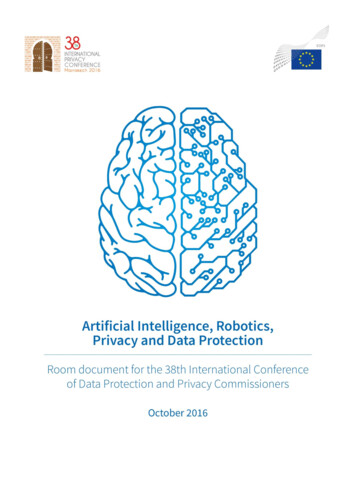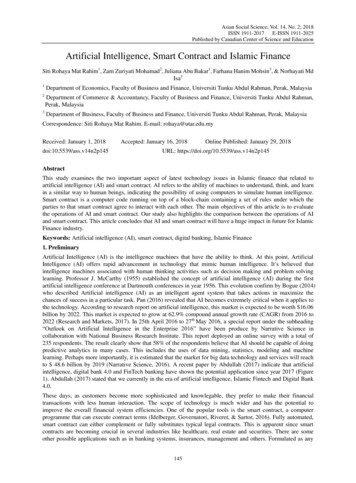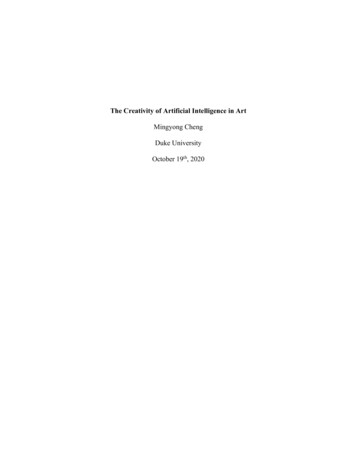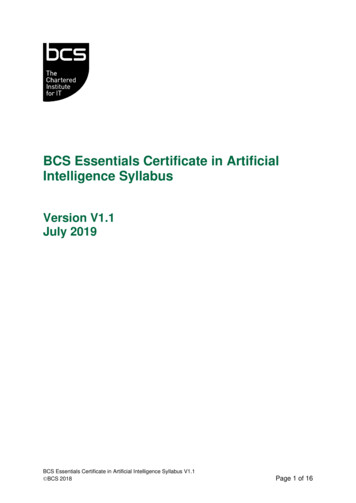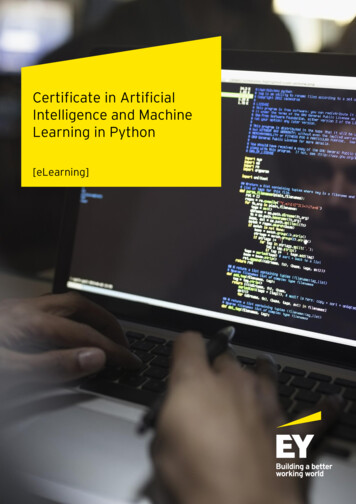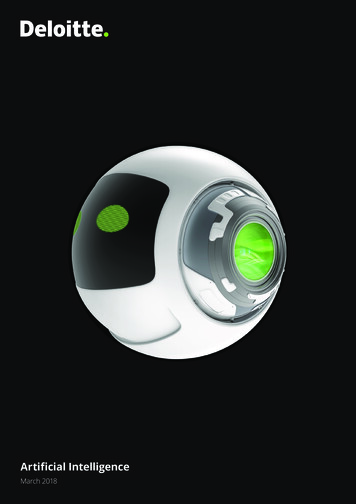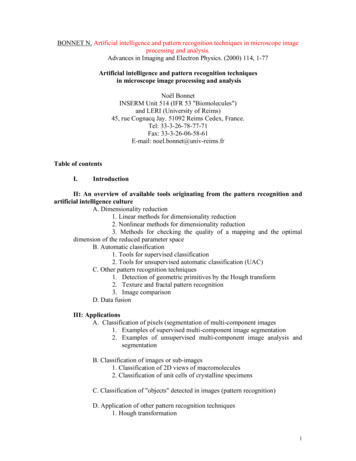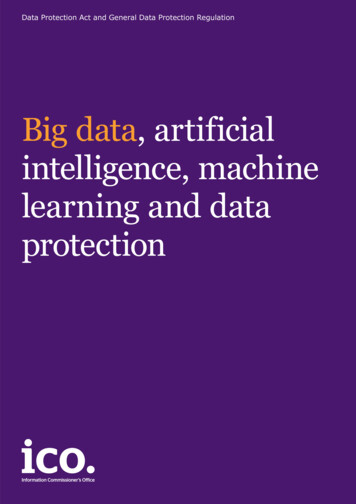
Transcription
Data Protection Act and General Data Protection RegulationBig data, artificialintelligence, machinelearning and dataprotection
ContentsInformation Commissioner’s foreword . 3Chapter 1 – Introduction . 5What do we mean by big data, AI and machine learning? . 6What’s different about big data analytics? . 9What are the benefits of big data analytics? . 15Chapter 2 – Data protection implications . 19Fairness . 19Effects of the processing . 20Expectations . 22Transparency . 27Conditions for processing personal data . 29Consent . 29Legitimate interests . 32Contracts . 35Public sector. 35Purpose limitation . 37Data minimisation: collection and retention . 40Accuracy . 43Rights of individuals . 46Subject access. 46Other rights . 47Security . 49Accountability and governance . 51Data controllers and data processors. 56Chapter 3 – Compliance tools . 58Anonymisation . 58Privacy notices . 62Privacy impact assessments . 70Privacy by design . 72Privacy seals and certification. 75Ethical approaches . 77Personal data stores . 84Algorithmic transparency . 86Chapter 4 – Discussion . 90Big data, artificial intelligence, machine learning and data protection20170904Version: 2.2
Chapter 5 – Conclusion . 94Chapter 6 – Key recommendations . 97Annex 1 – Privacy impact assessments for big data analytics. 99Big data, artificial intelligence, machine learning and data protection20170904Version: 2.22
Information Commissioner’s forewordBig data is no fad. Since 2014 when my office’s first paper on this subjectwas published, the application of big data analytics has spread throughoutthe public and private sectors. Almost every day I read news articlesabout its capabilities and the effects it is having, and will have, on ourlives. My home appliances are starting to talk to me, artificially intelligentcomputers are beating professional board-game players and machinelearning algorithms are diagnosing diseases.The fuel propelling all these advances is big data – vast and disparatedatasets that are constantly and rapidly being added to. And what exactlymakes up these datasets? Well, very often it is personal data. The onlineform you filled in for that car insurance quote. The statistics your fitnesstracker generated from a run. The sensors you passed when walking intothe local shopping centre. The social-media postings you made last week.The list goes on So it’s clear that the use of big data has implications for privacy, dataprotection and the associated rights of individuals – rights that will bestrengthened when the General Data Protection Regulation (GDPR) isimplemented. Under the GDPR, stricter rules will apply to the collectionand use of personal data. In addition to being transparent, organisationswill need to be more accountable for what they do with personal data.This is no different for big data, AI and machine learning.However, implications are not barriers. It is not a case of big data ‘or’data protection, or big data ‘versus’ data protection. That would be thewrong conversation. Privacy is not an end in itself, it is an enabling right.Embedding privacy and data protection into big data analytics enables notonly societal benefits such as dignity, personality and community, butalso organisational benefits like creativity, innovation and trust. In short,it enables big data to do all the good things it can do. Yet that’s not to saysomeone shouldn’t be there to hold big data to account.In this world of big data, AI and machine learning, my office is morerelevant than ever. I oversee legislation that demands fair, accurate andnon-discriminatory use of personal data; legislation that also gives me thepower to conduct audits, order corrective action and issue monetarypenalties. Furthermore, under the GDPR my office will be working hard toimprove standards in the use of personal data through theimplementation of privacy seals and certification schemes. We’re uniquelyplaced to provide the right framework for the regulation of big data, AIand machine learning, and I strongly believe that our efficient, joined-upand co-regulatory approach is exactly what is needed to pull back thecurtain in this space.Big data, artificial intelligence, machine learning and data protection20170904Version: 2.23
So the time is right to update our paper on big data, taking into accountthe advances made in the meantime and the imminent implementation ofthe GDPR. Although this is primarily a discussion paper, I do recognisethe increasing utilisation of big data analytics across all sectors and I hopethat the more practical elements of the paper will be of particular use tothose thinking about, or already involved in, big data.This paper gives a snapshot of the situation as we see it. However, bigdata, AI and machine learning is a fast-moving world and this is far fromthe end of our work in this space. We’ll continue to learn, engage,educate and influence – all the things you’d expect from a relevant andeffective regulator.Elizabeth DenhamInformation CommissionerBig data, artificial intelligence, machine learning and data protection20170904Version: 2.24
Chapter 1 – Introduction1.This discussion paper looks at the implications of big data, artificialintelligence (AI) and machine learning for data protection, andexplains the ICO’s views on these.2.We start by defining big data, AI and machine learning, andidentifying the particular characteristics that differentiate them frommore traditional forms of data processing. After recognising thebenefits that can flow from big data analytics, we analyse the mainimplications for data protection. We then look at some of the toolsand approaches that can help organisations ensure that their big dataprocessing complies with data protection requirements. We alsodiscuss the argument that data protection, as enacted in currentlegislation, does not work for big data analytics, and we highlight theincreasing role of accountability in relation to the more traditionalprinciple of transparency.3.Our main conclusions are that, while data protection can bechallenging in a big data context, the benefits will not be achieved atthe expense of data privacy rights; and meeting data protectionrequirements will benefit both organisations and individuals. After theconclusions we present six key recommendations for organisationsusing big data analytics. Finally, in the paper’s annex we discuss thepracticalities of conducting privacy impact assessments in a big datacontext.4.The paper sets out our views on the issues, but this is intended as acontribution to discussions on big data, AI and machine learning andnot as a guidance document or a code of practice. It is not acomplete guide to the relevant law. We refer to the new EU GeneralData Protection Regulation (GDPR), which will apply from May 2018,where it is relevant to our discussion, but the paper is not a guide tothe GDPR. Organisations should consult our website www.ico.org.ukfor our full suite of data protection guidance.5.This is the second version of the paper, replacing what we publishedin 2014. We received useful feedback on the first version and, inwriting this paper, we have tried to take account of it and newdevelopments. Both versions are based on extensive desk researchand discussions with business, government and other stakeholders.We’re grateful to all who have contributed their views.Big data, artificial intelligence, machine learning and data protection20170904Version: 2.25
What do we mean by big data, AI and machine learning?6.The terms ‘big data’, ‘AI’ and ‘machine learning’ are often usedinterchangeably but there are subtle differences between theconcepts.7.A popular definition of big data, provided by the Gartner IT glossary,is:“ high-volume, high-velocity and high-variety information assetsthat demand cost-effective, innovative forms of informationprocessing for enhanced insight and decision making.”1Big data is therefore often described in terms of the ‘three Vs’ wherevolume relates to massive datasets, velocity relates to real-time dataand variety relates to different sources of data. Recently, some havesuggested that the three Vs definition has become tired throughoveruse2 and that there are multiple forms of big data that do not allshare the same traits3. While there is no unassailable single definitionof big data, we think it is useful to regard it as data which, due toseveral varying characteristics, is difficult to analyse using traditionaldata analysis methods.8.This is where AI comes in. The Government Office for Science’srecently published paper on AI provides a handy introduction thatdefines AI as:“ the analysis of data to model some aspect of the world. Inferencesfrom these models are then used to predict and anticipate possiblefuture events.”41Gartner IT glossary Big data. http://www.gartner.com/it-glossary/big-data Accessed 20June 20162Jackson, Sean. Big data in big numbers - it's time to forget the 'three Vs' and look atreal-world figures. Computing, 18 February ree-vs-and-look-at-real-world-figures Accessed 7 December 2016 Accessed7December 20163Kitchin, Rob and McArdle, Gavin. What makes big data, big data? Exploring theontological characteristics of 26 datasets. Big Data and Society, January-June 2016 vol.3 no. 1. Sage, 17 February 2016.4Government Office for Science. Artificial intelligence: opportunities and implications forthe future of decision making. 9 November 2016.Big data, artificial intelligence, machine learning and data protection20170904Version: 2.26
This may not sound very different from standard methods of dataanalysis. But the difference is that AI programs don’t linearly analysedata in the way they were originally programmed. Instead they learnfrom the data in order to respond intelligently to new data and adapttheir outputs accordingly5. As the Society for the Study of ArtificialIntelligence and Simulation of Behaviour puts it, AI is thereforeultimately about:“ giving computers behaviours which would be thought intelligent inhuman beings.”69.It is this unique ability that means AI can cope with the analysis ofbig data in its varying shapes, sizes and forms. The concept of AI hasexisted for some time, but rapidly increasing computational power (aphenomenon known as Moore’s Law) has led to the point at whichthe application of AI is becoming a practical reality.10. One of the fasting-growing approaches7 by which AI is achieved ismachine learning. iQ, Intel’s tech culture magazine, defines machinelearning as:“ the set of techniques and tools that allow computers to ‘think’ bycreating mathematical algorithms based on accumulated data.”8Broadly speaking, machine learning can be separated into two typesof learning: supervised and unsupervised. In supervised learning,algorithms are developed based on labelled datasets. In this sense,the algorithms have been trained how to map from input to outputby the provision of data with ‘correct’ values already assigned tothem. This initial ‘training’ phase creates models of the world onwhich predictions can then be made in the second ‘prediction’ phase.5The Outlook for Big Data and Artificial Intelligence (AI). IDG Research, 11 November2016 nd-artificial-intelligence-ai/Accessed 7 December 2016.6The Society for the Study of Artificial Intelligence and Simulation of Behaviour. What isArtificial Intelligence. AISB Website. http://www.aisb.org.uk/public-engagement/what-isai Accessed 15 February 20177Bell, Lee. Machine learning versus AI: what's the difference? Wired, 2 December ng-ai-explained Accessed 7 December20168Landau, Deb. Artificial Intelligence and Machine Learning: How Computers Learn. iQ,17 August 2016. achine-learning/Accessed 7 December 2016.Big data, artificial intelligence, machine learning and data protection20170904Version: 2.27
Conversely, in unsupervised learning the algorithms are not trainedand are instead left to find regularities in input data without anyinstructions as to what to look for.9 In both cases, it’s the ability ofthe algorithms to change their output based on experience that givesmachine learning its power.11. In summary, big data can be thought of as an asset that is difficult toexploit. AI can be seen as a key to unlocking the value of big data;and machine learning is one of the technical mechanisms thatunderpins and facilitates AI. The combination of all three conceptscan be called ‘big data analytics’. We recognise that other dataanalysis methods can also come within the scope of big dataanalytics, but the above are the techniques this paper focuses on.9Alpaydin, Ethem. Introduction to machine learning. MIT press, 2014.Big data, artificial intelligence, machine learning and data protection20170904Version: 2.28
What’s different about big data analytics?12. Big data, AI and machine learning are becoming part of business asusual for many organisations in the public and private sectors. This isdriven by the continued growth and availability of data, includingdata from new sources such as the Internet of Things (IoT), thedevelopment of tools to manage and analyse it, and growingawareness of the opportunities it creates for business benefits andinsights. One indication of the adoption of big data analytics comesfrom Gartner, the IT industry analysts, who produce a series of ‘hypecycles’, charting the emergence and development of newtechnologies and concepts. In 2015 they ceased their hype cycle forbig data, because they considered that the data sources andtechnologies that characterise big data analytics are becoming morewidely adopted as it moves from hype into practice10. This is againsta background of a growing market for big data software andhardware, which it is estimated will grow from 83.5 billionworldwide in 2015 to 128 billion in 201811.13. Although the use of big data analytics is becoming common, it is stillpossible to see it as a step change in how data is used, withparticular characteristics that distinguish it from more traditionalprocessing. Identifying what is different about big data analyticshelps to focus on features that have implications for data protectionand privacy.14. Some of the distinctive aspects of big data analytics are: the use of algorithms the opacity of the processing the tendency to collect ‘all the data’ the repurposing of data, and the use of new types of data.10Sharwood, Simon. Forget big data hype says Gartner as it cans its hype cycle. TheRegister, 21 August t big data hype says gartner as it cans its hype cycle/ and Heudecker, Nick. Big data isn’t obsolete. It’s normal. GartnerBlog Network, 20 August 2015. snow-normal/ Both accessed 12 February 201611Big data market to be worth 128bn within three years. DataIQ News, 24 May be-worth-ps128bn-within-three-yearsAccessed 17 June 2016Big data, artificial intelligence, machine learning and data protection20170904Version: 2.29
In our view, all of these can potentially have implications for dataprotection.15. Use of algorithms. Traditionally, the analysis of a dataset involves,in general terms, deciding what you want to find out from the dataand constructing a query to find it, by identifying the relevantentries. Big data analytics, on the other hand, typically does not startwith a predefined query to test a particular hypothesis; it ofteninvolves a ‘discovery phase’ of running large numbers of algorithmsagainst the data to find correlations12. The uncertainty of theoutcome of this phase of processing has been described as‘unpredictability by design’13. Once relevant correlations have beenidentified, a new algorithm can be created and applied to particularcases in the ‘application phase’. The differentiation between thesetwo phases can be regarded more simply as ‘thinking with data’ and‘acting with data’14. This is a form of machine learning, since thesystem ‘learns’ which are the relevant criteria from analysing thedata. While algorithms are not new, their use in this way is a featureof big data analytics.16. Opacity of the processing. The current ‘state of the art’ in machinelearning is known as deep learning15, which involves feeding vastquantities of data through non-linear neural networks that classifythe data based on the outputs from each successive layer16. Thecomplexity of the processing of data through such massive networkscreates a ‘black box’ effect. This causes an inevitable opacity thatmakes it very difficult to understand the reasons for decisions madeas a result of deep learning17. Take, for instance, Google’s AlphaGo, a12Centre for Information Policy Leadership. Big data and analytics. Seeking foundationsfor effective privacy guidance. Hunton and Williams LLP, February News files/Big Data and Analytics February 2013.pdf Accessed 17 June 201613Edwards, John and Ihrai, Said. Communique on the 38th International Conference ofData Protection and Privacy Commissioners. ICDPPC, 18 October 2016.14Information Accountability Foundation. IAF Consultation Contribution: “Consent andPrivacy” – IAF response to the “Consent and Privacy” consultation initiated by the Officeof the Privacy Commissioner of Canada. IAF Website, July d-Privacy-Submitted.pdf Accessed 16 February 201715Abadi, Martin et al. Deep learning with differential privacy. In Proceedings of the 2016ACM SIGSAC Conference on Computer and Communications Security. ACM, October2016.16Marr, Bernard. What Is The Difference Between Deep Learning, Machine Learning andAI? Forbes, 8 December machine-learning-and-ai/#f7b7b5a6457f Accessed 8 December 2016.17Castelvecchi, Davide. Can we open the black box of AI? Nature, 5 October ack-box-of-ai-1.20731 Accessed 8December 2016Big data, artificial intelligence, machine learning and data protection20170904Version: 2.210
computer system powered by deep learning that was developed toplay the board game Go. Although AlphaGo made several moves thatwere evidently successful (given its 4-1 victory over world championLee Sedol), its reasoning for actually making certain moves (such asthe infamous ‘move 37’) has been described as ‘inhuman’18. This lackof human comprehension of decision-making rationale is one of thestark differentials between big data analytics and more traditionalmethods of data analysis.17. Using all the data. To analyse data for research, it’s oftennecessary to find a statistically representative sample or carry outrandom sampling. But a big data approach is about collecting andanalysing all the data that is available. This is sometimes referred toas ‘n all’19. For example, in a retail context it could mean analysingall the purchases made by shoppers using a loyalty card, and usingthis to find correlations, rather than asking a sample of shoppers totake part in a survey. This feature of big data analytics has beenmade easier by the ability to store and analyse ever-increasingamounts of data.18. Repurposing data. A further feature of big data analytics is the useof data for a purpose different from that for which it was originallycollected, and the data may have been supplied by a differentorganisation. This is because the analytics is able to mine data fornew insights and find correlations between apparently disparatedatasets. Companies such as DataSift20 take data from Twitter (viaTwitter’s GNIP service), Facebook and other social media and make itavailable for analysis for marketing and other purposes. The Officefor National Statistics (ONS) has experimented with using geolocatedTwitter data to infer people’s residence and mobility patterns, tosupplement official population estimates21. Geotagged photos onFlickr, together with the profiles of contributors, have been used as areliable proxy for estimating visitor numbers at tourist sites andwhere the visitors have come from22. Mobile-phone presence data18Wood, Georgie. How Google’s AI viewed the move no human could understand. Wired,14 March 2016. ve-no-humanunderstand/ Accessed 8 December 2016.19Mayer-Schönberger, Viktor and Cukier, Kenneth, in Chapter 2 of Big data. A revolutionthat will transform how we live, work and think. John Murray, 201320http://datasift.com21Swier, Nigel; Komarniczky, Bence and Clapperton, Ben. Using geolocated Twittertraces to infer residence and mobility. GSS Methodology Series no. 41. ONS, October2015. ogrammes-andprojects/the-Data form smart meters ons-big-data-project/index.html Accessed 19February 201622Wood, Spencer A et al. Using social media to quantify nature-based tourism andrecreation. Nature Scientific Reports, 17 October 2013http://www.nature.com/articles/srep02976 Accessed 26 February 2016Big data, artificial intelligence, machine learning and data protection20170904Version: 2.211
can be used to analyse the footfall in retail centres23. Data aboutwhere shoppers have come from can be used to plan advertisingcampaigns. And data about patterns of movement in an airport canbe used to set the rents for shops and restaurants.19. New types of data. Developments in technology such as IoT,together with developments in the power of big data analytics meanthat the traditional scenario in which people consciously provide theirpersonal data is no longer the only or main way in which personaldata is collected. In many cases the data being used for the analyticshas been generated automatically, for example by tracking onlineactivity, rather than being consciously provided by individuals. TheONS has investigated the possibility of using data from domesticsmart meters to predict the number of people in a household andwhether they include children or older people24. Sensors in the streetor in shops can capture the unique MAC address of the mobilephones of passers-by25.20. The data used in big data analytics may be collected via these newchannels, but alternatively it may be new data produced by theanalytics, rather than being consciously provided by individuals. Thisis explained in the taxonomy developed by the InformationAccountability Foundation26, which distinguishes between four typesof data – provided, observed, derived and inferred: Provided data is consciously given by individuals, eg whenfilling in an online form. Observed data is recorded automatically, eg by online cookiesor sensors or CCTV linked to facial recognition. Derived data is produced from other data in a relatively simpleand straightforward fashion, eg calculating customer profitability23Smart Steps increase Morrisons new and return customers by 150%. TelefonicaDynamic Insights, October 2013 step-ahead-for-morrisons Accessed 20 June 201624Anderson, Ben and Newing, Andy. Using energy metering data to support officialstatistics: a feasibility study. Office for National Statistics, July mmesandprojects/theonsbigdataproject Accessed 26 February 201625Rice, Simon. How shops can use your phone to track your every move and videodisplay screens can target you using facial recognition. Information Commissioner’sOffice blog, 21 January 2016. ops-can-use-your-phone-to-track-your-every-move/ Accessed 17 June 201626Abrams, Martin. The origins of personal data and its implications for governance.OECD, March 2014. loads/DataOrigins-Abrams.pdf Accessed 17 June 2016Big data, artificial intelligence, machine learning and data protection20170904Version: 2.212
from the number of visits to a store and items bought. Inferred data is produced by using a more complex method ofanalytics to find correlations between datasets and using theseto categorise or profile people, eg calculating credit scores orpredicting future health outcomes. Inferred data is based onprobabilities and can thus be said to be less ‘certain’ thanderived data.IoT devices are a source of observed data, while derived and inferreddata are produced by the process of analysing the data. These all sitalongside traditionally provided data.21. Our discussions with various organisations have raised the questionwhether big data analytics really is something new and qualitativelydifferent. There is a danger that the term ‘big data’ is appliedindiscriminately as a buzz word that does not help in understandingwhat is happening in a particular case. It is not always easy (orindeed useful) to say whether a particular instance of processing is oris not big data analytics. In some cases it may appear to be simply acontinuation of the processing that has always been done; forexample, banks and telecoms companies have always handled largevolumes of data and credit card issuers have always had to validatepurchases in real time. Furthermore, as noted at the start of thissection, the technologies and tools that enable big data analytics areincreasingly becoming a part of business as usual.22. For all these reasons, it may be difficult to draw a clear line betweenbig data analytics and more conventional forms of data use.Nevertheless, we think the features we have identified aboverepresent a step change. So it is important to consider theimplications of big data analytics for data protection.23. However, it is also important to recognise that many instances of bigdata analytics do not involve personal data at all. Examples of nonpersonal big data include world climate and weather data; usinggeospatial data from GPS-equipped buses to predict arrival times;astronomical data from radio telescopes in the Square KilometreArray27; and data from sensors on containers carried on ships. Theseare all areas where big data analytics enable new discoveries andimprove services and business processes, without using personaldata. Also, big data analytics may not involve personal data for otherreasons; in particular it may be possible to successfully anonymisewhat was originally personal data, so that no individuals can be27Square Kilometre Array website https://www.skatelescope.org/ Accessed 17 June2016Big data, artificial intelligence, machine learning and data protection20170904Version: 2.213
identified from it. We discuss this in more detail in the section onanonymisation in chapter 3.24. Still, it is obvious that other examples of big data analytics do involvepersonal data. The data may directly identify individuals, or they maybe identified by apparently anonymous datasets being combined. Insuch cases, the question of whether the processing complies withdata protection principles is unavoidable.Big data, artificial intelligence, machine learning and data protection20170904Version: 2.214
What are the benefits of big data analytics?25. In 2012 the Centre for Economics and Business Research estimatedthat the cumulative benefit to the UK economy of adopting big datatechnologies would amount to 216 billion over the period 2012-17,and 149 billion of this would come from gains in businessefficiency28.26. There are obvious commercial benefits to companies, for example inbeing able to understand their customers at a granular level andhence making their marketing more targeted and effective.Consumers may benefit from seeing more relevant advertisementsand tailored offers and from receiving enhanced services andproducts. Fo
Big data, artificial intelligence, machine learning and data protection 20170904 Version: 2.2 6 What do we mean by big data, AI and machine learning? 6. The terms ‘big data’, ‘AI’ an
